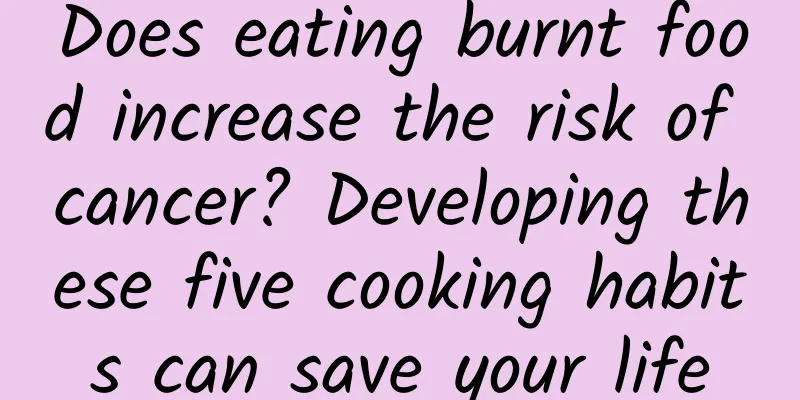Does eating burnt food increase the risk of cancer? Developing these five cooking habits can save your life

|
This article was reviewed by Pa Li Ze, chief physician of nutrition, member of the Science Popularization Committee of the Chinese Nutrition Society In the daily cooking process, it is inevitable that food will be burnt or charred. If it is only slightly burnt, many people will choose to continue eating it, but if the whole food turns black, they will often throw away the whole food. Copyright image, no permission to reprint Of course, there are a few people who like this kind of crispy feeling. For example, some people like to eat the burnt part of the roasted sweet potatoes on the street. When buying scones, they also like to have them burnt a little, so that they are crispy, crunchy and fragrant... However, it is widely rumored online that "burnt food cannot be eaten and will cause cancer!" What is the truth? How many carcinogens are contained in burnt food? When it comes to food, temperature can make or break it. The right temperature can not only kill pathogens and parasites in food, but also soften the fiber, reduce anti-nutritional factors, dissolve amino acid flavoring substances, make the taste better, and make many nutrients easier to digest and absorb; However, when food is heated to too high a temperature, healthy ingredients such as vitamin C, B vitamins, and unsaturated fatty acids are destroyed, and some harmful substances may be produced, including carcinogens. Moreover, different carcinogens are produced at different temperatures: 1. Heated to 120°C, acrylamide (Class 2A carcinogen) is coming to you Foods containing carbohydrates and amino acids (such as potatoes, bread, steamed buns, etc.) are prone to "Maillard reaction" after being cooked at high temperatures above 120°C. This reaction has always been popular in the culinary world because it can make food appear brown and produce aromatic substances such as furan, pyrazine, thiophene, thiazole, etc., which makes people more appetizing. However, some harmful byproducts are also produced in this process, the most important of which is acrylamide. Copyright image, no permission to reprint However, although acrylamide has certain neurotoxic effects, the amount of acrylamide in general food is not a cause for concern. As long as you don't eat it too frequently, don't eat too much at one time, and make sure to eat it with fresh vegetables and fruits, it is safe. Tip: Fried and baked high-starch foods contain relatively higher levels of acrylamide. If you are really concerned about food-borne acrylamide, it is recommended to eat less potato chips, French fries, toast, fried potatoes, etc. 2. Heterocyclic amines (Class 1 carcinogens) are waving at you when heated to 200°C Cooking protein-rich foods such as livestock, poultry, and fish at high temperatures and for long periods of time may produce heterocyclic amines. Generally speaking, the higher the heating temperature, the longer the cooking time, and the less water content of the food, the more heterocyclic amines are produced. Studies have found that heterocyclic amines are carcinogenic and mutagenic, and are associated with liver cancer, colorectal cancer, breast cancer, prostate cancer and other cancers. 3. When heated to 300°C, benzopyrene (Class 1 carcinogen) appears. When the oil temperature is too high, especially when it exceeds 300℃, the lipids will undergo thermal cracking reaction, producing polycyclic aromatic hydrocarbons, the most notorious of which is "benzopyrene", a strong carcinogen. Moreover, the total amount of benzopyrene produced when the food is burnt is much greater than when it is not burnt. It has been proven that long-term exposure to benzopyrene can not only cause lung cancer, but also digestive tract cancer, bladder cancer, breast cancer, etc. Therefore, whether food poses a risk of cancer cannot be determined simply by looking at whether it is burnt. Will eating burnt food definitely cause cancer? uncertain. The Japanese Cancer Research Association once conducted an experiment, which found that feeding charred food directly to hamsters can indeed induce liver cancer in hamsters. However, if the food is charred and mixed into feed before being fed, even if it is fed to hamsters for their entire lives (the lifespan of hamsters is about 2 years), the experiment did not find that the hamsters would get cancer. As the saying goes, "It is irresponsible to talk about toxicity without considering the dosage." Therefore, as long as you follow the principle of food diversity in your daily diet, eating a little bit of burnt food will not cause cancer. Although it may not cause cancer, the nutrients in the burnt part of the food are almost completely destroyed and have no health benefits. Therefore, eat less if possible, and don't eat it if you can avoid it. Daily cooking How to reduce the generation of harmful substances? In addition to burnt food, incorrect cooking procedures can also quietly harm your body and even increase your risk of cancer! Therefore, keep the following precautions in mind: 1. Drain the water and put it in the pot If the ingredients are not drained when cooking, they will splash violently when in contact with the oil and quickly vaporize into many tiny particles, so that the PM2.5 value may be higher than that of frying. Long-term inhalation of these tiny particles is likely to cause damage to the lungs, increasing the risk of pneumonia and even lung cancer. 2. Hot pan with cold oil Many people like to wait until the oil smokes before putting food in the pan. However, when the oil pan smokes, the oil temperature may have reached over 200℃. Putting the food in the pan at this time will not only destroy the nutrition of the food, but may also cause the protein, fat and carbohydrates in the food to mutate and produce some carcinogens. Copyright image, no permission to reprint Therefore, it is recommended to use a hot pan and cold oil when cooking. 3. Tips for different cooking methods It is best to choose steaming, boiling, and mixing methods for cooking, and when stir-frying, deep-frying, and baking, you should learn to master some tips to reduce the harm: ① When stir-frying, heat the pan with cold oil and stir-fry quickly over high heat; you can also blanch the food until half-cooked before stir-frying to reduce the time of high-temperature cooking. ② When frying food, you can cook the food first to shorten the frying time; you can also use batter to isolate some of the temperature; you should use fresh oil every time. ③ When grilling, do not use open charcoal, use an electric grill instead; wrap the food with tin foil to protect it from "smoke and fire"; grilled food can be marinated with onions, ginger, garlic, lemon juice, etc., which can reduce the production of heterocyclic amines when grilling; cut the meat into small pieces, or cook the meat to half-cooked in advance, and it will be cooked through with a little grilling, shortening the time of high-temperature heating. 4. Wash the pot in time It is also wrong to cook the next dish without cleaning the pan! Because the seemingly clean surface of the pot will be attached with grease and food residues, when it is heated at high temperature again, carcinogens such as benzopyrene may be produced; and when you continue to cook without washing the pot, you will find that the food residues are easily burnt, which increases the formation of carcinogens. Copyright image, no permission to reprint So after cooking one dish, be sure to clean the pan before cooking the next one. 5. Keep the range hood on all the time Oil smoke may contain more than 200 harmful substances such as benzopyrene, acrolein, heterocyclic amine compounds, etc., which are very harmful to health. According to a survey, people who are exposed to high-temperature oil fumes in the kitchen for a long time have a 2 to 3 times higher chance of developing lung cancer than ordinary people. For people who already have respiratory diseases such as asthma, pneumonia, etc., these harmful substances can also aggravate their condition. Suggestion: Always turn on the range hood when cooking. After cooking, some fumes will remain in the kitchen and pipes, so try to keep the range hood on for 3 to 5 minutes after cooking to ensure that harmful gases are fully discharged. Source: I am a great doctor official account The watermarked images and cover images in this article are from the copyright gallery, and the image content is not authorized for reprinting |
<<: World Obesity Day | Forward! You can lose weight by eating this way without going hungry
>>: How to eat the healthiest "Oriental Diet"? Interpretation of the Dietary Guidelines Part 2
Recommend
Selling 196 million in one day, how did Himalaya achieve growth?
Himalaya was established in 2012. Its previous po...
KIET: Chinese electric vehicles will account for 33.1% of the Korean market in 2024
A report released this month by the Korea Institu...
How much does it cost to find an African to record a blessing video? Where can I buy the video of black people shouting slogans?
What is the most fashionable way to send blessing...
@Spacecraft: Watch out! Earth lightning and space "killer electron rain"
Author: Huang Xianghong Duan Yuechu In recent yea...
Postpartum recovery: abdominal shaping after cesarean section
Postpartum repair and cesarean section abdominal ...
How to attract traffic on Weibo? Precise traffic generation techniques on Weibo!
In this era, many people are scrambling to gather...
Game live streaming platform: Douyu, Huya competitive product analysis report
In this article, the author attempts to analyze t...
Actual combat case | 11 steps to build a product data operation system
This article will explain in detail the "11 ...
Apple releases first developer preview of iOS 11.4 beta
Not long ago, Apple officially pushed out iOS 11....
2021 China Advertising Industry Cooperation Ecosystem Report!
The cooperative relationship between advertisers ...
What did you say? I can't hear you without my glasses.
People with myopia often have a feeling After tak...
Why does my country have to pursue carbon neutrality? I understand it after reading this
Hello everyone, I am Brother Ma Ma, who has small...
Belief is priceless! The long-delayed ASUS ROG Claymore RGB mechanical keyboard is still worth buying
God said, "Let there be light," and the...
In-depth analysis from 0 to 1: What is KOL operation?
What I talk about most with friends recently is K...
The new Internet advertising regulations will be implemented on September 1st. Have you thought about how to deal with it?
On July 8, 2016, the State Administration for Ind...









